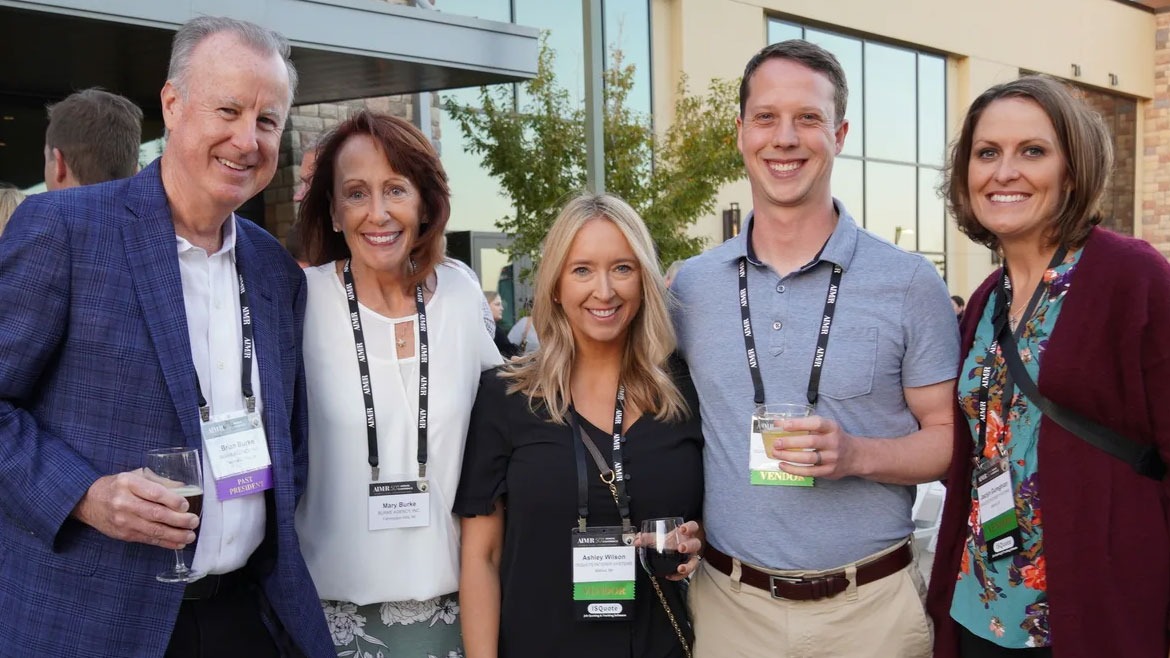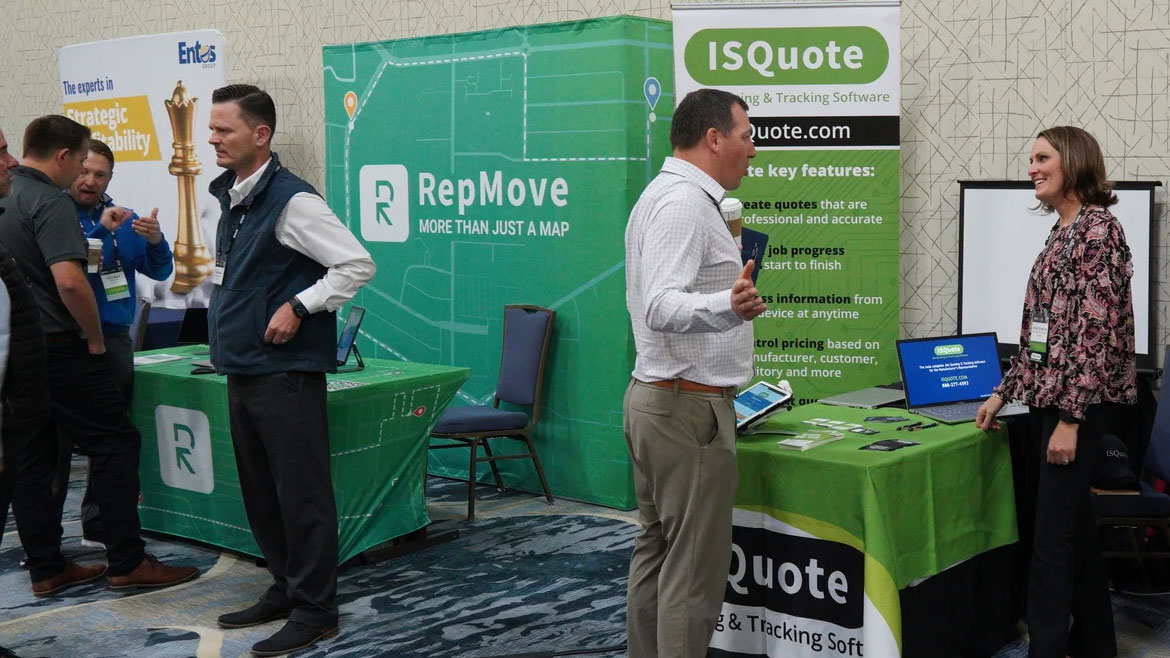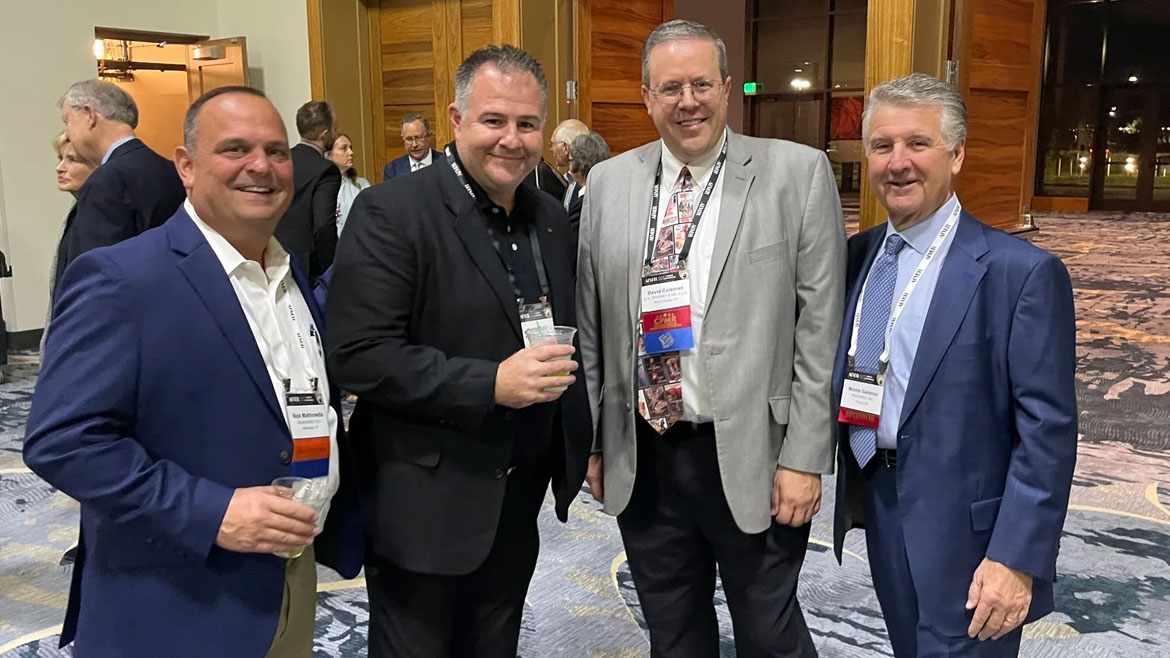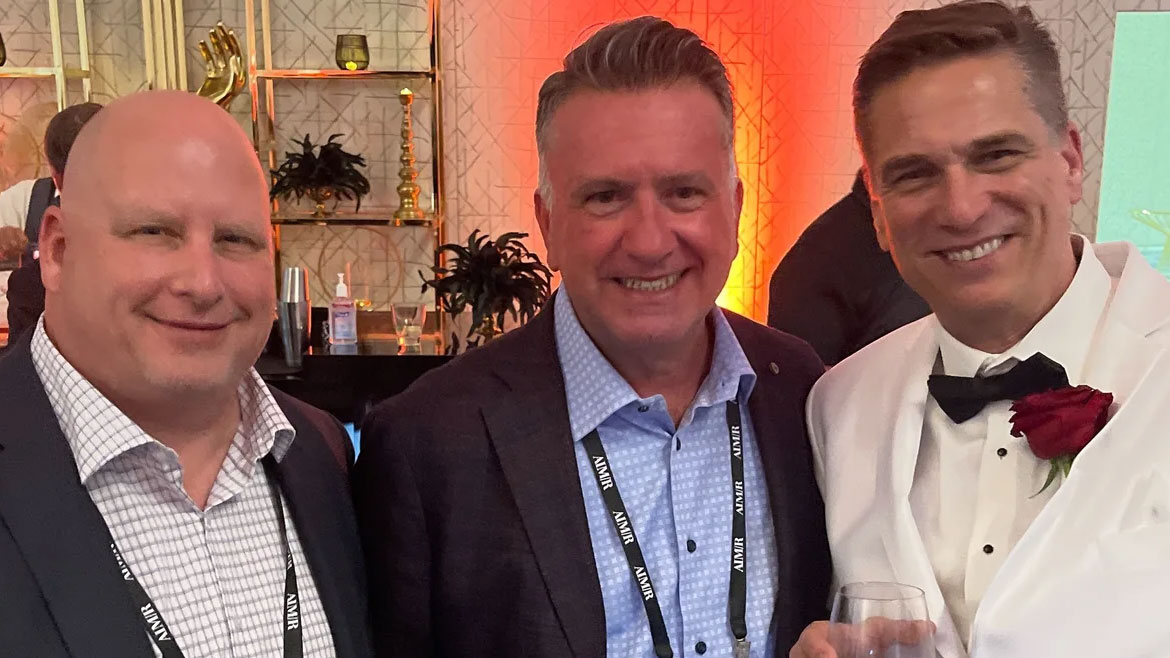The Association of Independent Manufacturers’ Representatives (AIM/R) members certainly showed up ready to celebrate for the association’s 50th annual conference at the Gaylord Rockies Resort and Convention Center in Aurora, Colorado this October. The event brought 470 total attendees, all of whom took full advantage of the many networking, education and celebration opportunities.
In addition to a thought-provoking keynote address from author and President of Battle Tested Coaching Blake Williams, reps participated in rep-led roundtable discussions on topics such as technology, tracking customer quotes and succession planning. The conference also included an economic outlook from Alan Beaulieu, president, ITR Economics, and several other rep-led educational sessions including, “How to Create a Balanced and Synergistic Line Card,” “How to Build a Rock Solid Contract,” and “The Future of Your Inside MI6 Team.”
As always, to hear first-hand from reps on the state of the market, challenges and the evolving role of manufacturers’ reps, Supply House Times held its annual Rep Council roundtable discussion where five engaged AIM/R members gather to discuss the hot-topics. This year’s participants were:
Heath Williams, MBA, president, Pepco Sales & Marketing;
Jamie Hill, CPMR, president, W.R. Bristow Manufacturers’ Agents;
Lauren Butler, vice president, TM Sales;
Justin Pfeifer, CPMR, vice president/principal, Southwest Sales; and
Joe Herkowski, CPMR, owner, Herkowski Stickler & Associates.
These reps agree that while the past year has been one filled with new challenges, tasks and roles, it has also been a year of extreme success. “With our offices in Chicago and Milwaukee, it has been a tremendous year in terms of sales,” Herkowski explains. “Taking inflation into account, we have been fortunate to see positive growth in terms of both sales dollars and overall units.”
Although there has been talk of residential market decline in certain parts of the country, Herkowski says both commercial and residential projects are peaking in the midwest. Reps in other parts of the country agree, noting that the peaking residential market is expected to cool off as new construction residential starts have slowed down in some areas.
“In Georgia we are starting to see a slight slow down in contractor buying when it comes to residential new construction,” Hill explains. “With interest rates climbing, people are holding off on buying, so we are prepared for the residential market to cool for a while.”
Pfeifer points out that the Texas market has continued to have a strong economy and high housing demand despite the challenges over the past two years. “We are starting to see a cooling residential market, but the demand for new housing is still there,” he says.
The reps point out that the multifamily and built-for-rent markets are filled with promising demand. “With the lack of affordability and rising interest rates, people cannot afford to buy a home, so we are seeing a huge shift toward more multifamily and build to rent projects,” Pfeifer adds.
Also in Texas, Williams agrees, saying he is optimistic about the health of the multifamily market. “We are also very optimistic about the commercial sector; that’s where we are going to focus a much our efforts moving forward. However, we will continue to defend our share in the multifamily and residential markets.”
AN EVOLVING ROLE: SELLING VS. REPORTING
As reps adapt to the wild ride that is today’s economy, they are also constantly adapting to the new data and information customers and manufacturers expect from them.
“It’s safe to say all of our manufactures are requiring more from us than ever before,” Pfeifer says. “Data is knowledge, and data management is essential. As reps, we must find a way to deliver data in a manner our manufacturers can utilize, while still growing in this ever-changing environment.”
When it comes to data management, these reps agree that having processes internally to understand and best utilize the data, before even relaying it to manufacturers and/or customers, is vital. To make this happen, some have created new roles in their organizations dedicated to data management.
AIM/R’s 50th annual conference at the Gaylord Rockies Resort and Convention Center in Aurora, Colorado brought 470 total attendees, all of whom took full advantage of the many networking, education and celebration opportunities.
“We now have a Business Intelligence Manager on staff,” Pfeifer says. “She handles our CRM, Power Bi, and numerous data reporting activities.”
Pfeifer points out that with these new roles comes new learning processes and ongoing development. “The needs of the workforce have changed,” he says. “Employees thrive on feedback and consistent development opportunities. We’ve created a Learning Management System to ensure we are offering consistent training and development for our employees.”
Reps are tackling data both internally and externally. “We have internal data to sort through as well as data coming from all of our manufacturers,” Williams points out. “The challenge is managing all of the different systems in which we receive and deliver this data. Some manufacturers utilize spreadsheets or other on-off documents while others use online software or their own CRM. We plan to customize our own system to increase efficiencies and be proactive in our approach to deliver valuable information to our manufacturers.”
Although many areas of the country are operating business as usual post-pandemic, Butler points out that in Colorado, she still have many customers that are not back in the office and maybe do not plan to go back. “I still have a lot of purchasing agents who are still working remotely,” she says. “So we have had to continuously adapt and be creative in the ways we deliver information and data.”
The reps agree that these days when it comes to data, being proactive, instead of reactive, is key. “Rather than waiting to be asked for data, we have taken a proactive approach to have data collected and organized, sending it out to our manufacturers before they ask for it,” Pfeifer says.
Herkowski brings up the labor shortage, noting that reps need to take on more of a service role than what was needed in the past. “Our contractors are facing the same or worse saturation when it comes to labor, so we have taken on more of a service role to deliver added value for our contractors who don’t have the time or man power to deal with certain things on their end.”
Both inside and outside sales teams have to adopt, understand and utilize this increasing amount of data, and there has been talk industry-wide about the evolving roles of inside and outsides sales. The consensus among these participants is that inside sales teams were the backbone of businesses during the height of supply chain disruption, but both inside and outside sales have taken on new roles that require more from them than ever before. Now, it’s about finding a way to balance sales with reporting.
“The challenge for outside sales has been continuing to drive demand for new product releases and stay up to date with training in an incredibly challenging marketplace,” Herkowski explains. “As for our inside team, the value they bring has never been higher. They are the people who got us through a very tough period of time.”
Reps agree that both sales roles have evolved to include keeping customers updated more than before. “The amount of phone calls we handled throughout the pandemic doubled,” Pfeifer notes. “Now we are back to a place where we can focus on selling.”
Herkowski agrees, saying the goal is to find a middle road for all salespeople. “Our people are really great at what they do — driving demand and fostering relationships,” he says. “So it’s our goal to get back to a middle ground where they aren’t behind a computer all day crunching numbers; we want them selling and doing what they’re meant to do.”
TOP CHALLENGES: FINDING PEOPLE AND PRODUCT
When discussing the conditions of today’s supply chain, reps say overall, things are better than the past couple of years, but issues are still arising all the time.
“It’s really a merry go round of which product we are going to have issues receiving this time,” Hill says. “If there isn’t constant communication, things fall apart.”
Pfeifer says today’s supply chain conditions are better than a year ago, but nowhere near pre-pandemic levels. “We see cycles of recovery. While lead times have improved, they are still unstable. These challenges have us taking new approaches, such as working closer with our wholesale distributors.”
Pfeifer adds that reps have become a vital resource for distributors as they adjust inventory practices from just in time, to just in case. “We are collaborating with our distributors; providing and utilizing data to help predict demand and make recommendations for inventory adjustments.”
Butler points out another challenge stemming from the unstable supply chain. “A year ago, distributors where just ordering whatever they could get their hands on because there was so much desperation for product,” she says. “Now we are spending a ton of time reducing what SKUs are stocked at the wholesale level and working to gain back our position, making sure that distributors go back to ordering with their sole source.”
One huge piece of the supply chain that has also been struggling is the freight and fleet sector. “We've seen a lot of our manufacturers rely more heavily on our three warehouses in Texas to stock more material,” Williams says.
Summarizing the supply chain challenges at hand, Herkowski brings it back to the importance of transparent communication. “Those manufacturers and reps that have owned communication have kind of won the day with the supply chain. While those that haven't, really distanced themselves.”
To no surprise, the participants cite labor as the single greatest challenge they face today. Manufacturers’ reps are seeking to fill sales roles, which is a role not just anyone can do. “We don’t have a labor shortage, we have a shortage of qualified candidates that are ready and willing to work,” Williams says. “At Pepco, we have hired a third party recruiter, which is a significant investment.”
Pfeifer agrees, noting that the role of rep has evolved with the expanding market, and the need for a high quality workforce continues to rise. Previous hiring practices, such as networking to recruit new talent, is no longer a viable solution.
Finding qualified candidates isn’t the only problem. Butler adds that the expectations of potential employees today are much higher than the past. “One of the problems we run is that someone with zero experience will come in asking for an extremely large salary and wanting to know what the roadmap is to go higher, and how quickly they can get there.”
The participants add that the entire country is competing for labor right now, so it continues to get more and more expensive to recruit and keep candidates.
“Traditionally, we would follow the three Cs when hiring: Character, chemistry and competency,” Williams points out. “Now it’s to the point where we just focus on character and chemistry and rely on our numerous experienced employees within our firm to help train the competencies.”
A CRITICAL PART OF THE SUPPLY CHAIN
The roundtable discussion could have went on for hours, as with each question asked the participants discussed amongst each other how they are tackling these challenges. This type of networking is exactly what reps cite as one of the greatest values AIM/R brings to the industry.
Hill describes AIM/R as a “resource of commonality,” that he can pick up the phone at any time and get in touch with a business just like his for a second opinion.
Pfeifer agrees, also calling out AIM/R’s power to advocate on behalf of reps, “AIM/R provides our agency with an opportunity to learn best practices from other reps and network with reps from other areas that we would not typically interact with,” he says. “It also provides educational opportunities throughout the year and is a strong advocate for our industry.”
AIM/R held its first ever gala to celebrate the 50th annual conference. Attendees enjoyed a James Bond themed evening event to close out a successful conference.
Herkowski echoes the importance of a strong network within AIM/R, bringing up the ability to connect with manufacturers as well. “Still a big part of AIM/R is the networking and getting to hear some of the top reps in the country open up about the successes they have seen in their business,” he says. “The chance to hear from manufactures about issues they see moving forward within the rep community is invaluable as well.”
Coming off of several trying but fruitful years, these reps feel the value they bring the supply chain is more secure than ever.
The value we bring is being true market experts,” Hill says. “Generally, we have market knowledge by proxy because of who we call on. Contractors and Wholesalers feed us knowledge that we can share with others to help their business.”
Herkowski agrees, noting the reps have power to drive demand at various levels of the supply chain. “Reps hold the ability to reach the secondary levels of our industry, which is extremely successful in driving demand for our principal partners.”
Pfeifer summarizes the critical role of manufacturers’ reps well by pointing to their value add for distributors and manufacturers.
“For our manufacturers, we provide timely sales forecasts, unit demand forecasts for large projects, and a timeline of when products will be needed. This information is crucial for manufacturers to properly plan their procurement and production cycles. Without this information, they would not be able to quickly adjust their production capabilities to meet the constant challenges of a given market,” he explains. “For our wholesale customers, we provide them with lead-time updates, make recommendations for product substitutions, provide analysis based on their current demand vs. current inventory vs. open orders, and make suggestions on when and how much product should be purchased. This level of detail helps our wholesalers insure they have a consistent inventory level to meet their customer’s needs.”

















